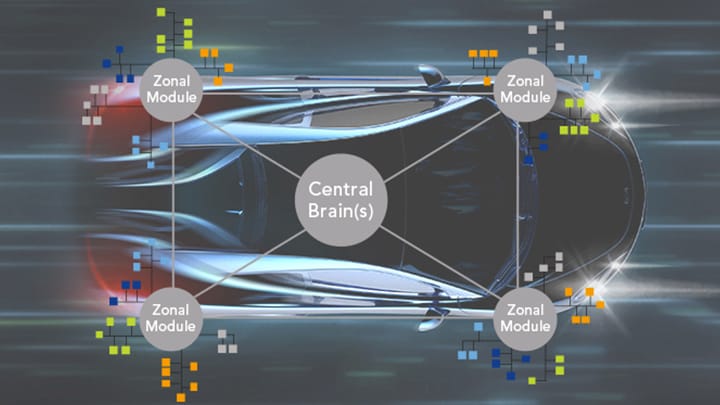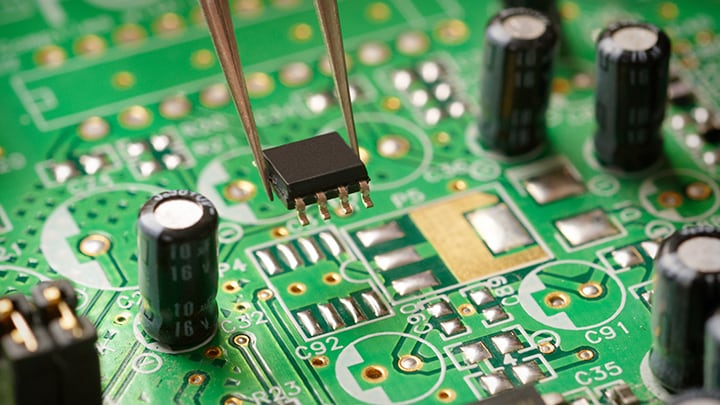The S32G family of vehicle network processors just doubled in size with today's production launch of the
S32G3 series offering up to 2.5x the
performance, memory and networking bandwidth as the S32G2 series. The new S32G3 processors are package pinout- and
software-compatible with the S32G2 processors, allowing for a customer design to scale ~10x in performance to support multiple
product tiers or increase product performance over time. The
S32G family now scales from a triple dual-core
lockstep microcontroller to a quad dual-core lockstep microcontroller + octal high-performance microcomputer, offering a
processing range of 3.9k to 36k DMIPS.
 S32G2 vs S32G3 performance and compatibility
S32G2 vs S32G3 performance and compatibility
The Need for Speed (and More)
As the automotive industry shifts to domain and zonal architectures, cross-domain functional integration drives the need for
more processing and memory, as well as isolation domains for freedom from interference. The S32G3 processors address processing
needs with up to four lockstep pair of Arm® Cortex®-M7 microcontroller cores and up to eight
Cortex-A53 application cores (which can be optionally cluster lockstep for four pairs) and increasing the frequency by 30% to
1.3 GHz. System RAM was increased up to 20 MB to support more and larger microcontroller applications and the isolation domains
were doubled to 16 domains. Additionally, to support the higher number of cores and applications, system and watchdog timers
were increased.
Being vehicle network processors with network acceleration, the S32G3 network capabilities were also enhanced for higher vehicle
data bandwidths. The low latency communication engine (LLCE) supports up to 5 Mbit/s CAN FD traffic on all 16 interfaces and the
packet forwarding engine (PFE) supports up to 2.5 Gbit/sec on all three Ethernet interfaces.
| Package |
525 FC-PBGA, 19 x 19 mm, 0.8 mm pitch |
| Arm Core Cluster 1 |
- |
1x Cortex-A53 @ 1 GHz |
2x Cortex-A53 @ 1 GHz |
2x Cortex-A53 @ 1.3 GHz |
4x Cortex-A53 @ 1.3 GHz |
| Arm Core Cluster 2 |
- |
1x Cortex-A53 @ 1 GHz |
2x Cortex-A53 @ 1 GHz |
2x Cortex-A53 @ 1.3 GHz |
4x Cortex-A53 @ 1.3 GHz |
| Applications DMIPS |
- |
4600-5990(*) |
9200.11980(*) |
12000-15500(*) |
24000-31100(*) |
| Arm Real-time LS Cores |
3x Cortex-M7, 400 MHz |
1x Cortex-M7, 400 MHz |
3x Cortex-M7, 400 MHz |
3x Cortex-M7, 400 MHz |
3x Cortex-M7, 400 MHz |
4x Cortex-M7, 400 MHz |
3x Cortex-M7, 400 MHz |
4x Cortex-M7, 400 MHz |
| Real-time DMIPS |
3900 |
1300 |
3900 |
3900 |
5200 |
3900 |
5200 |
| DDR |
- |
LPDDR4 / DDR3L 32 bit (Up to 4GB) |
| System SRAM |
8 MB |
6 MB |
8 MB |
15 MB |
20 MB |
15 MB |
20 MB |
| NVM-IF |
Octal DDR NOR, eMMC/SDXC NAND |
| AI / ML |
- |
Arm Cortex Neon:
16 GFLOPS
|
Arm Cortex Neon:
32 GFLOPS
|
Arm Cortex Neon:
41.6 GFLOPS
|
Arm Cortex Neon:
83.2 GFLOPS
|
| PCIe |
1x PCIe 2.0 (2 lanes) |
2x PCIe 3.0 (2 lanes) |
| Ethernet Acceleration |
Packet Forwarding Engine (PFE)
2 Gbps @ 64B forwarding
3 ext ports
|
Packet Forwarding Engine (PFE2)
3 Gbps @ 64B forwarding
3 ext ports
|
Accelerated
Ethernet Ports (PFE) Automotive
Network Acceleration
|
2x 1 G/100M
1x 2.5G/1G/100M
|
3x 2.5G/1G/100M |
Low Latency Communication Engine (LLCE)
CAN FD x16 / LIN x4 / FR x1
|
Low Latency Communication Engine (LLCE2)
CAN FD x16 / LIN x4 / FR x1
|
Non-Accelerated IF
CAN FD / LIN / FR
Gb ETH / USB 2.0
SPI / I2C
|
4 / 3 / 1
1 / 0
6 / 5
|
4 / 3 / 1
1 / 1
6 / 5
|
| Timer |
12 FlexTimer, 7 System Timer, 7 Watchdog Timer |
12 FlexTimer, 13 System Timer, 12 Watchdog Timer |
| ADC |
2x 6-ch SAR ADC, 12-bit |
| Temp Range |
-40 to 105°C (Tj=125°C) |
S32G3 Enhancements over S32G2
(*) Cortex-A53 DMIPS performance based on 2.995 DMIPS/MHz measured on S32G2 silicon
|
Accelerating Software-Defined Vehicles
S32G3 processors are being used by carmakers for central vehicle compute in software-defined vehicles (SDVs) to host vehicle
services, integrate cross-domain functions (virtual ECUs), provide secure gateway functionality and manage vehicle-wide
over-the-air (OTA) updates. The combination of Arm Cortex-M7 and Cortex-A53 processor cores is attractive to host a combination
of real-time functions and applications, including safety-critical applications that can run on safety-certified operating
systems and hypervisors while leveraging hardware isolation called eXtended Resource Domain Control (XRDC) and support for ISO
26262 ASIL D functional safety needs. The networking accelerators (LLCE and PFE) offload the processor cores from managing data
streams and packets and can be used for accelerated intrusion detection and prevention systems (IDPS). The hardware security engine (HSE) supports public key infrastructure (PKI) cryptography with hardware acceleration to manage over-the-air updates
within the device and across the vehicle. In some cases, dual S32G3 processors are used in vehicle computers for further
isolation between vehicle services and secure gateway functionality, further showing their versatility.
GoldVIP for S32G3 is a vehicle
integration platform that integrates NXP, open-source and partner software to provide an out-of-the box solution for rapidly
developing software and prototyping a vehicle computer. It includes a hypervisor with multiple virtual machines, Linux and
support for the K3s lightweight Kubernetes environment for vehicle services deployment. Additionally, it supports
AWS cloud services
leveraging AWS IoT Greengrass and AWS IoT FleetWise to streamline vehicle-to-cloud support, along with OTA services from Airbiquity for a cloud-enabled, out-of-the box experience.
NXP’s S32G3 processors are ideal for vehicle computer and safety processing applications. Explore the vast array of software enablement available for NXP S32G3.
Ideal for Safety Processing
S32G3 processors are also being used for safety processing or as a domain controller for ADAS or autonomous vehicles because
they offer a high level of safe processing with the Cortex-M7 and Cortex-A53 cores, as well as support for multi-Gigabit
Ethernet and four lanes of PCI Express Gen3 support which can interface directly and efficiently with perception processors. In
addition to built-in functional safety circuitry and a companion VR5510 ASIL D power management IC (PMIC), the
S32 Safety Software Framework
is available to streamline safety software development. The S32G3 performs functions such as safety checking, redundant decision
making, domain control and vehicle actuation with these systems. With the S32G3, safety processing performance can be taken to
the high level needed for modern ADAS/AV applications where traditional ASIL D microcontrollers get to their limits. The S32G
family is attractive to carmakers for its compatible scalability that can provide safety across fleets and into the future.
 S32G3 Target Applications
S32G3 Target Applications
Design Today with S32G3 Processors
The S32G3 processors have strong enablement support with evaluation and reference design boards, as well as software, tools and
partner ecosystem. The automotive-grade
Reference Design Board 3 (RDB3)
and GoldBox 3 are hardware platforms for
desktop/lab and in-vehicle prototyping/testing respectively. Design information is provided by NXP, including schematics,
bill-of-materials and layout information to help accelerate customers' hardware designs.
As mentioned previously, the S32G GoldVIP offers out-of-the-box software integration for rapid development, along with the
individual software components. Software development is supported by
NXP's S32 Design Studio IDE
and tools, along with the
FreeMASTER™ run-time debugging and visualization tool.
Additionally, the S32G3 processors are supported by an ecosystem of partners that offer solutions such as training, hardware,
development tools, operating environments, applications, cloud services and more. You can start to develop applications for
S32G3 today with boards available through NXP and distribution partners and software available from the S32G3 page.
 S32G3 Partner Ecosystem
S32G3 Partner Ecosystem
Key S32G3 Takeaways
The S32G3 series of processors extend the range of the S32G2 family by adding four new processors today that are in production
with hardware and software available for your evaluation and development, supported by a strong partner ecosystem. The S32G3
processors are ideal for vehicle computer and safety processing applications, but they are versatile and are expected to be used
in other high-performance automotive processing applications such as gateways and domain controllers, as well as being in
adjacent markets such as transportation and industrial.







